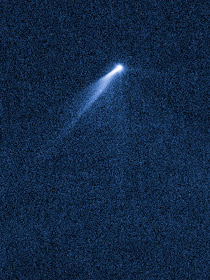Since 2005, during my work on comets and asteroids, I discovered a number of asteroids. Recently I submitted name proposals for a couple of my discoveries. Names for minor planets are proposed by the discoverer of a specific object after the object is numbered. Proposals are accompanied by a brief citation explaining the reasons for the naming (see here for more info about the procedure).
Suggested names were submitted to Minor Planet Center and approved by the Committee for Small Body Nomenclature (CSBN) of the IAU (International Astronomical Union).
The Minor Planet Circular MPC 85415- 85916 issued on November 20, 2013 announces that asteroid 152319 (2005 UH7) is now officially named "Pynchon" and the asteroid 152481 (2005 WY57) is now officially named "Stabia". I choosed asteroid "Pynchon" to honor great American novelist Thomas Pynchon known almost exclusively through his writing, dense and complex. While asteroid "Stabia" honors the city of Castellammare di Stabia in Italy where I was born.
The official citations for the asteroids read:
(152319) Pynchon = 2005 UH7
Discovered 2005 Oct. 29 by E. Guido at Mayhill.
Thomas R. Pynchon, Jr. (b. 1937) is an American novelist. He was the winner of the 1974 U.S. National Book Award for Fiction for his most celebrated novel, Gravity’s Rainbow.
(152481) Stabia = 2005 WY57
Discovered 2005 Nov. 30 by E. Guido at Mayhill.
Castellammare di Stabia is a city in southern Italy. The city is located close to the ancient Roman town of Stabiae, which was destroyed by the eruption of Mount Vesuvius in 79 CE.
The Minor Planet Circular MPC 85415- 85916 issued on November 20, 2013 announces that asteroid 152319 (2005 UH7) is now officially named "Pynchon" and the asteroid 152481 (2005 WY57) is now officially named "Stabia". I choosed asteroid "Pynchon" to honor great American novelist Thomas Pynchon known almost exclusively through his writing, dense and complex. While asteroid "Stabia" honors the city of Castellammare di Stabia in Italy where I was born.
The official citations for the asteroids read:
(152319) Pynchon = 2005 UH7
Discovered 2005 Oct. 29 by E. Guido at Mayhill.
Thomas R. Pynchon, Jr. (b. 1937) is an American novelist. He was the winner of the 1974 U.S. National Book Award for Fiction for his most celebrated novel, Gravity’s Rainbow.
(152481) Stabia = 2005 WY57
Discovered 2005 Nov. 30 by E. Guido at Mayhill.
Castellammare di Stabia is a city in southern Italy. The city is located close to the ancient Roman town of Stabiae, which was destroyed by the eruption of Mount Vesuvius in 79 CE.
Asteroid "Pynchon" resides in the Main Asteroid Belt, between Mars and Jupiter, of the Solar System; with an estimated size about 2 km - 4 km, it takes 4.10 years to complete a revolution around the Sun.
Asteroid "Stabia" resides in the Main Asteroid Belt, between Mars and Jupiter, of the Solar System; with an estimated size about 3 km - 6 km, it takes 5.55 years to complete a revolution around the Sun.
Asteroid "Stabia" resides in the Main Asteroid Belt, between Mars and Jupiter, of the Solar System; with an estimated size about 3 km - 6 km, it takes 5.55 years to complete a revolution around the Sun.
On the JPL website you can find a 3D orbit visualization tool for (152319) Pynchon and for (152481) Stabia.
Click on the image below to see a snippet from MPC 85415- 85916.
Click on the images below to see the orbit of asteroids "Pynchon" and "Stabia"
 |
| Credit: JPL Small-Body Database |
 |
| Credit: JPL Small-Body Database |
by Ernesto Guido










